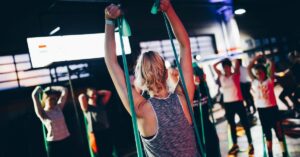Transform Your Recovery Process with These Expert-Approved Mobility Techniques

Transform Your Recovery Process with These Expert-Approved Mobility Techniques
Have you ever found yourself staring blankly at a foam roller, wondering if you’re the only one who feels like a pretzel while trying to stretch? You’re not alone. Recovery, particularly for athletes and fitness enthusiasts, is often a neglected aspect of training that can make or break performance. Yet, with the right mobility techniques, you can significantly enhance your recovery, reduce injury risk, and improve overall performance. Let’s dive into some expert-approved mobility techniques that can transform your recovery process.
The Importance of Mobility in Recovery
Mobility isn’t just a buzzword thrown around in fitness circles; it’s a crucial component of physical health that affects everything from muscle function to joint integrity. When we talk about mobility, we’re referring to the ability of your joints to move freely through their full range of motion. It’s not just about flexibility (though that’s part of it) but includes stability and strength as well. As I’ve learned through years of writing about sports and fitness, neglecting mobility can lead to compensatory patterns that ultimately result in injuries. A significant number of athletes experience chronic pain or injuries due to tight muscles and restricted movement patterns.
Understanding the Basics of Mobility Techniques
Before we get into the nitty-gritty of mobility techniques, it’s essential to understand a few fundamentals:
- Dynamic Stretching: This involves moving parts of your body through their full ranges of motion. Think leg swings or arm circles.
- Static Stretching: Holding a stretch for 15-60 seconds. This is great post-workout but should be approached with caution before exercises.
- Foam Rolling: Also known as self-myofascial release, this technique targets knots in muscles to improve blood flow and movement.
- Joint Mobility Exercises: These are focused movements designed to improve the range of motion in specific joints.
Expert-Approved Mobility Techniques
Now that we’ve covered the basics, let’s delve into several mobility techniques that are widely endorsed by experts in the field. I remember attending a workshop led by a renowned physical therapist who emphasized that these techniques are not just for athletes; they can benefit anyone looking to enhance their quality of life.
1. The Power of Foam Rolling
Let’s begin with foam rolling—an absolute staple in the recovery arsenal. This technique can help alleviate muscle soreness and improve flexibility. But, how do you go about it? Here’s a quick guide:
Start with your calves, rolling slowly and applying pressure. If you find a particularly sore spot, don’t rush past it; linger there for a few seconds. Transition to your hamstrings, quads, and finally, your upper back. (I’ve often found that rolling out the upper back can be surprisingly satisfying after a long day.) Aim for about 10-15 minutes of foam rolling as part of your recovery routine.
2. Dynamic Warm-Ups
Before any workout, a dynamic warm-up is crucial. It prepares your muscles for the work ahead and promotes better mobility. Picture this: you’re about to hit the track for a sprint session. Instead of jumping straight into your all-out sprints, you might perform a series of dynamic movements such as:
- Leg swings (forward and sideways)
- Walking lunges with a twist
- High knees or butt kicks
These movements not only get the blood pumping but also prime your muscles and joints for action. I can’t tell you how many times I’ve seen athletes skip this step only to regret it when they pull a muscle mid-sprint.
3. Joint Mobility Drills
Joint mobility drills are like giving your joints a little tune-up. These exercises can help maintain and improve your range of motion. Consider incorporating movements like:
- Hip circles
- Shoulder dislocates with a resistance band
- Ankle pumps
These might seem simple, but the benefits can be substantial. I once interviewed a professional soccer player who swore by his daily joint mobility routine, claiming it was the secret to his longevity in the sport. Who doesn’t want to play the game they love for as long as possible?
4. Static Stretching Post-Workout
Let’s not overlook static stretching. While it’s often debated whether it should be performed before a workout, there’s no doubt about its importance afterward. After a rigorous training session, your muscles are often tight and fatigued, making it the perfect time to elongate them.
Focus on major muscle groups—hamstrings, quadriceps, and hip flexors. Hold each stretch for 30 seconds to ensure you’re getting the most out of it. And remember, breathing deeply can help relax your muscles and enhance the stretch. (Trust me, I often forget to breathe deeply when I’m trying to hold a stretch, and it makes a world of difference when I do!)
5. Incorporate Yoga and Pilates
Yoga and Pilates are not just trendy exercises for Instagram; they are excellent tools for enhancing mobility. Both practices emphasize controlled movements, balance, and flexibility. I recall my first yoga class—I was a bit hesitant, but I walked away feeling like a new person. It’s all about finding your flow, right?
These practices help in building core strength, which is essential for stabilizing your body during other activities. Regularly attending classes or following online sessions can yield significant benefits in your mobility and recovery process.
Creating a Personalized Mobility Routine
Now that we’ve explored these expert-approved techniques, it’s time to talk about how you can create a personalized mobility routine that fits your lifestyle and needs. It’s not a one-size-fits-all approach, and that’s what makes it exciting!
Assess Your Needs
Start by evaluating your current level of mobility and identifying any specific areas that feel tight. Spend a moment reflecting on your activities—do you run, lift weights, or play sports? Knowing your own body’s needs is crucial. If you’re unsure, consider consulting with a fitness professional or physical therapist who can provide valuable insights.
Set Specific Goals
Setting clear and achievable goals is essential. Whether you want to improve your hip mobility for that elusive squat depth or increase shoulder flexibility for overhead lifts, having specific targets will keep you motivated. Remember, progress takes time, and patience is key.
Incorporate Variety
Variety is the spice of life—and mobility routines are no exception. Mix and match the techniques we’ve discussed. Perhaps one day you focus primarily on foam rolling, while another day is dedicated to yoga. Keeping it fresh can help prevent boredom and sustain your commitment.
Make It Daily
Consistency is what breeds improvement. Aim to incorporate mobility work into your daily routine, even if it’s just for 10-15 minutes. Think of it as brushing your teeth—an essential part of your health routine.
Monitoring Progress and Adjusting Techniques
Once you’ve established your routine, it’s vital to monitor your progress. Keep a journal of your mobility exercises, noting how you feel before and after. Over time, you should notice improvements in your range of motion, reduced muscle soreness, and perhaps even enhanced performance in your chosen activities.
As you progress, don’t hesitate to adjust your techniques. Maybe you’ll discover that you need more focus on a particular muscle group or that a new stretch feels particularly effective. The beauty of mobility work is that it’s always evolving—much like your own body.
Common Pitfalls to Avoid
As with any practice, there are common pitfalls to be aware of. Let’s take a moment to highlight a few:
- Skipping Warm-Up: No matter how rushed you are, never skip the warm-up. It’s your body’s way of preparing for movement and preventing injuries.
- Overdoing It: While it’s important to challenge your body, overextending can lead to more harm than good. Listen to your body; if you feel pain, it’s a sign to back off.
- Neglecting Consistency: Once you find a routine that works, stick with it. Consistency is key to seeing results.
Conclusion: Embrace the Journey
Transforming your recovery process with expert-approved mobility techniques is about more than just physical benefits; it’s about embracing the journey of self-improvement. Remember, mobility is a lifelong endeavor, and the more you invest in it, the greater the rewards you’ll reap—not just in your athletic performance, but in your overall quality of life.
As you embark on or continue this journey, keep an open mind, be patient with yourself, and, most importantly, enjoy the process. Mobility work can be a game-changer, one stretch at a time. So roll out that foam roller, take a deep breath, and let’s get moving!






